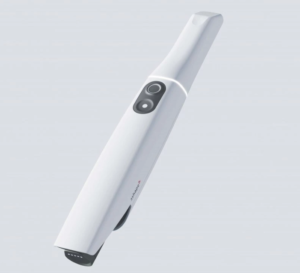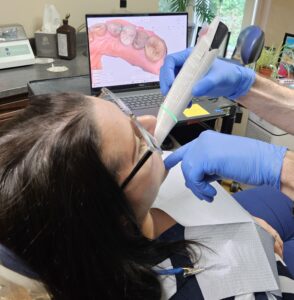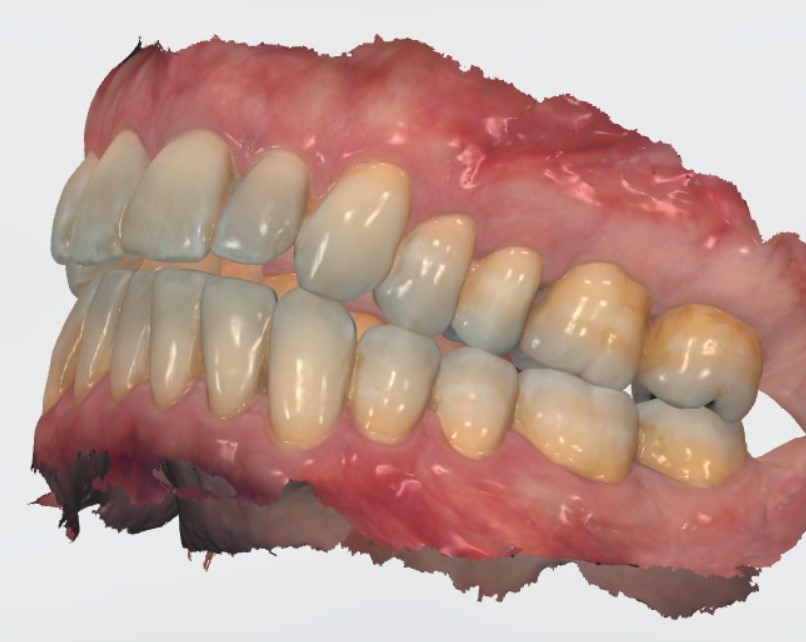
Our Wireless Digital Scanner
Are you tired of the messy, goopy, gag-inducing impression materials? You’re not alone.
Dr. Calcaterra uses an intraoral scanner (also called a digital scanner) to make high quality images of your mouth – thus eliminating the need for those unpleasant impressions of the past. With sub-millimeter precision, our 3D scanner takes and records detailed measurements of every single tooth and the entire oral cavity. The record is then stored digitally in the cloud.
We use the Trios 5 scanner by 3Shape – considered by many to be the gold standard in the industry – winning awards for most accurate digital scanner for many years. This commitment to investments in new technology allow us to continue to be one of the most modern dental offices in all of Orange, CT.
Benefits of the Intraoral Scanner
- Patient Comfort – By far the biggest benefit, the intraoral scanner can be used to obtain a complete (and accurate representation) of your mouth without the discomfort of a traditional impression. This means no bad tasting impression material, no gagging, no fear that you will gag, etc.
- Accuracy – Most intraoral scanners – and most importantly – the Trios 5 scanner used by us – will produce a 3D representation of your mouth that is far more accurate than what could be captured with even the best physical impression material. This means better fitting crowns/bridges/implants/etc – resulting in easier and quicker appointments for you.
- Quicker Turnaround from the Lab – Previously, the physical impression would have to picked up by the lab, with that impression then taking at least 2-3 days before it can be analyzed. No more! With a scanner, Dr. Calcaterra sends the digital file nearly immediately, and the lab can be looking at the case within a couple of hours. The end result is a quicker and more efficient process for you.
- Patient Education/Communication – While most patients have little desire to “see” their mouth in great detail, some do. The scan of your mouth is an incredible educational tool that can demonstrate why treatment is necessary, and what can be done to avoid costly and painful procedures in the future.
- Safe Technology – Unlike digital x-rays, which emit tiny amounts of radiation, the intraoral scanner is completely safe, simply taking and compiling highly detailed photographs of your mouth. There is no radiation involved.
How do we use the Intraoral Scanner?

Dr. Nick Calcaterra scanning a patient in our office.
- We begin by entering all of your information into the laptop controlling the scanner. This includes the procedure we are performing (crown, bridge, implant, sportsguard, etc.)
- A sterile, single-use sleeve is placed over the scanner.
- We then scan the desired area. If we are scanning your entire mouth, we can usually capture the entire area in approximately 3 minutes. We slowly move the camera throughout the mouth with the scanner taking multiple digital photos per second. There is no gagging, no smelly impression material, no pain, or any discomfort.
- As we scan the area, the image is rendered on our computer. This allows us to see in real time if there are areas we need to re-scan or other issues.
- We then send the file to a secure server, where it can be sent within minutes to various labs, shared with specialists, etc. Because our lab(s) receive the cases quickly and digitally, the resulting prostheses (crowns, nightguards, etc.) are returned more quickly and are of higher quality.
What the Scan Looks Like
We realize that up close pictures of teeth – even if they are computer generated – are not always what people want to see. But we wanted to show you the incredible detail that we are able to capture:

This is a screenshot from our digital scanner. Notice the incredible detail. The enhanced accuracy gives us better results. In addition, we are able to use the digital file to send to our lab, coordinate with specialists, and many other uses.
